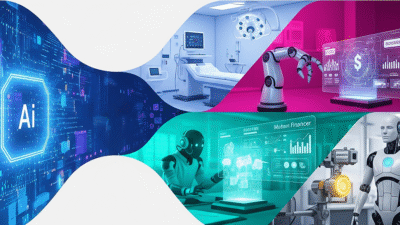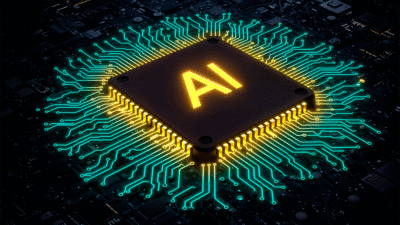In 2025, artificial intelligence and machine learning have moved beyond buzzwords to become essential drivers of business innovation and competitive advantage.
Organizations across industries are harnessing the power of AI-ML to automate processes, gain deeper insights from data, and create more personalized customer experiences. At Webashlar, we specialize in developing practical, business-focused AI-ML solutions that deliver measurable results.
Table of Contents:
- Introduction
- Understanding AI and ML
- Key Business Benefits of AI-ML
- Industry-Wise Applications of AI-ML
- AI-ML in Business Functions
- Challenges and Ethical Considerations
- Best Practices for Implementing AI-ML
- Future Outlook of AI-ML in Business
- Conclusion
1. Introduction
Artificial Intelligence (AI) and Machine Learning (ML) are no longer futuristic technologies. In 2025, they have become central to digital transformation strategies across industries. Businesses of all sizes are integrating AI-ML to gain operational efficiencies, drive innovation, enhance customer experiences, and maintain a competitive edge. This blog explores the wide-ranging impact of AI-ML development on business, offering deep insights into its advantages, applications, and future potential.
2. Understanding AI and ML
- Artificial Intelligence (AI) and Machine Learning (ML) are often used interchangeably, but they represent different concepts within the realm of intelligent technology.Understanding their distinction and synergy is key to grasping how they power modern business solutions.
- Artificial Intelligence (AI) is the broader concept of machines being able to carry out tasks in a way that we would consider “smart.” This includes abilities such as understanding language, recognizing patterns, solving problems, and making decisions. AI systems aim to replicate human cognitive functions and can range from rule-based systems to complex neural networks.
- Machine Learning (ML) is a subset of AI that focuses on enabling machines to learn from data. Instead of being explicitly programmed to perform every task, ML algorithms analyze large volumes of data, detect patterns, and make decisions or predictions based on past experiences. The more data an ML model processes, the more accurate and effective it becomes.
AI encompasses various techniques including machine learning, natural language processing (NLP), computer vision, and robotics while ML is specifically about algorithms that improve automatically through experience. For instance, an AI system that powers a chatbot may use ML to continuously learn from customer interactions and improve its responses over time.
Understanding the difference is crucial for businesses aiming to implement intelligent solutions. AI provides the foundation for building smart systems, and ML acts as the engine that makes these systems more adaptive, responsive, and intelligent through data.
3. Industry-Wise Applications of AI-ML
Artificial Intelligence and Machine Learning are reshaping industries by enabling smarter, faster, and more efficient operations. From healthcare to finance and retail to manufacturing, AI-ML technologies are unlocking new possibilities, automating complex tasks, and delivering insights that drive innovation and strategic decision-making.
Each industry benefits uniquely from these technologies, based on its specific needs, data availability, and operational challenges:
- Healthcare: AI-ML enables early disease detection, predictive diagnostics, personalized treatment plans, and efficient hospital resource management. Machine learning models are being used to interpret medical images, forecast patient outcomes, and even accelerate drug discovery.
- Finance: Financial institutions leverage AI-ML for fraud detection, algorithmic trading, credit scoring, customer risk profiling, and robo-advisory services. These technologies help improve accuracy, reduce human error, and enhance compliance in a highly regulated environment.
- Retail & E-commerce: AI personalizes shopping experiences, automates inventory management, and powers recommendation engines. ML models help retailers forecast demand, optimize pricing, and enhance customer service through chatbots and virtual assistants.
- Manufacturing: In manufacturing, AI-ML powers predictive maintenance, process automation, quality inspection, and supply chain optimization. Smart factories utilize real-time data to reduce downtime, improve product quality, and lower operational costs.
- Logistics & Transportation: Companies use AI-ML for route optimization, real-time tracking, demand forecasting, and autonomous delivery systems. These technologies enhance delivery speed, reduce fuel costs, and increase customer satisfaction.
- Education: AI enhances learning through intelligent tutoring systems, personalized learning paths, and automated grading. ML also supports predictive analytics to improve student outcomes and resource planning.
- Real Estate: From property price prediction and virtual tours to targeted marketing and customer segmentation, AI-ML helps real estate businesses operate more efficiently and deliver better customer experiences.
4. AI/ML in Business Functions
AI and ML are no longer confined to specialized tech teams. they’re being embedded across core business functions to streamline processes, uncover insights, and drive strategic growth. From marketing and sales to HR and finance, AI-ML technologies are transforming the way departments operate and deliver value.
- Marketing: AI-ML empowers marketers with deep customer insights and real-time analytics. Machine learning algorithms enable predictive customer behaviour analysis, segmentation, and personalized content delivery. Sentiment analysis helps understand public perception, while AI-driven automation tools optimize ad placement and campaign performance with minimal manual input.
- Sales: In sales, AI-ML enhances lead scoring, sales forecasting, and customer relationship management. Predictive models analyze past interactions and buying patterns to prioritize high-potential leads. Sales teams use AI tools to automate follow-ups, suggest upselling opportunities, and even generate tailored pitch materials.
- Human Resources (HR): AI-ML simplifies recruitment, employee engagement, and workforce planning. Intelligent systems screen resumes, conduct initial assessments, and predict candidate success. ML models also detect patterns related to employee turnover, helping HR teams take proactive steps to improve retention and satisfaction.
- Finance & Accounting: Financial departments use AI-ML for tasks like automated bookkeeping, fraud detection, and financial forecasting. These technologies reduce human error, increase compliance accuracy, and allow faster data-backed decision-making. Algorithms can also analyze spending trends to recommend cost-saving strategies.
- Customer Support: Conversational AI, including chatbots and virtual assistants, is revolutionizing customer service. These tools provide instant, consistent responses across platforms, resolve common issues, and route complex queries to human agents. ML ensures that support systems improve continuously through user interactions.
- IT & Security: AI-ML enhances cybersecurity by detecting anomalies, identifying threats in real-time, and automating responses to incidents. IT operations benefit from intelligent monitoring systems that predict downtimes, optimize infrastructure performance, and reduce manual troubleshooting.

5. Challenges and Ethical Considerations
While AI and ML offer transformative benefits to businesses, they also introduce significant challenges and ethical dilemmas that cannot be ignored. As organizations increasingly adopt these technologies, they must address key issues related to privacy, bias, transparency, and accountability to ensure responsible and sustainable innovation.
- Data Privacy and Security: AI-ML systems rely heavily on data often personal or sensitive in nature. Improper data collection, usage, or storage can lead to breaches of user privacy and legal violations. Organizations must implement strong data governance policies and ensure compliance with regulations like GDPR, HIPAA, and others.
- Algorithmic Bias and Fairness: AI models can unintentionally reflect or amplify societal biases present in training data. This can lead to unfair outcomes, such as discrimination in hiring, lending, or law enforcement applications. Ensuring fairness requires careful dataset curation, continuous auditing, and bias mitigation strategies during model development.
- Transparency and Explainability: Many AI systems, especially those using deep learning, operate as “black boxes” producing results without clear explanations of how they were derived. This lack of transparency can erode trust among users and stakeholders. Businesses must prioritize explainable AI (XAI) approaches that make model logic more understandable and traceable.
- Job Displacement and Workforce Transition: As AI automates repetitive and routine tasks, concerns about job displacement grow. While new roles are being created, organizations must invest in upskilling and reskilling programs to help employees adapt to AI-enhanced work environments, rather than be replaced by them.
- Accountability and Responsibility: It iscomplex when decisions are driven by algorithms. Companies must establish clear ethical guidelines and legal frameworks to ensure that AI systems are used responsibly and that human oversight is maintained.
- Regulatory and Legal Challenges: AI adoption often outpaces regulation, leading to uncertainty and risk. As global governments develop frameworks to manage AI, businesses must stay ahead by incorporating ethical practices and legal compliance into their development cycles from the start.
6. Best Practices for Implementing AI-ML
Successfully implementing AI and ML in a business environment requires more than just access to data or advanced algorithms. It demands a strategic, well-planned approach that aligns technology with business goals. Following best practices ensures scalable, ethical, and effective deployment of AI-ML solutions.
- Align AI-ML Initiatives with Business Objectives: Start by identifying clear business problems where AI or ML can create measurable value. Whether it’s improving customer retention, automating internal processes, or enhancing forecasting accuracy, technology should serve strategic goals—not the other way around.
- Build a Strong Data Foundation: High-quality, relevant, and well-organized data is the backbone of any AI-ML project. Invest in data governance, cleaning, integration, and labeling to ensure your models learn from accurate and diverse data sources.
- Start Small and Scale Gradually: Begin with pilot projects to test feasibility and measure impact. These smaller experiments allow your team to refine approaches, gain internal buy-in, and develop a roadmap for broader implementation across departments or functions.
- Involve Cross-Functional Teams: AI-ML projects should not be isolated within the IT or data science departments. Collaborate with domain experts, business leaders, and end-users to ensure the solution is practical, accurate, and usable in real-world contexts.
- Focus on Explainability and Trust: Choose algorithms and frameworks that provide transparency. Stakeholders are more likely to adopt and trust AI solutions when they understand how decisions are made.
7. Future Outlook of AI-ML in Business
The future of AI and ML in business is both promising and transformative. As these technologies continue to evolve, their role will expand from automating tasks to fundamentally reshaping how companies innovate, compete, and deliver value. Businesses that proactively embrace AI-ML will be better positioned to thrive in an increasingly data-driven, digital-first economy.
- AI as a Core Business Driver: AI-ML will no longer be treated as niche technologies or support tools. They will become central to business models, guiding strategic decisions, optimizing operations, and shaping customer experiences in real time.
- Hyper-Personalization at Scale: Future AI systems will deliver highly individualized experiences across marketing, product recommendations, and services by continuously learning from user behaviour and context. Businesses will use this capability to build deeper customer loyalty and engagement.
- Intelligent Automation Beyond Routine Tasks: While today’s AI automates repetitive tasks, future AI will handle more complex, decision-intensive workflows across industries such as legal, finance, logistics, and healthcare resulting in smarter, leaner operations.
- Seamless Human-AI Collaboration: The workplace will evolve into a hybrid environment where humans and intelligent systems work side-by-side. AI will augment human capabilities suggesting insights, handling mundane work, and enabling employees to focus on creative, strategic, or empathetic tasks.
- Proliferation of Low-Code and No-Code AI Tools: AI-ML development will become more accessible to non-technical users, enabling broader innovation across departments. Business users will build custom AI models using intuitive platforms without needing deep programming expertise.
9. Conclusion
The impact of AI-ML development on business is profound and transformative. From enhancing efficiency to unlocking new revenue streams, AI-ML technologies are becoming indispensable tools for modern enterprises. By adopting a strategic, ethical, and data-driven approach, businesses can harness the full potential of AI-ML to thrive in the digital era.





Your insights are refreshing and thought-provoking. I can’t wait to implement these tips!
I’m so glad you found the insights helpful! I appreciate your comment.
I didn’t realize how much I could improve my work until I read this post. Thank you!